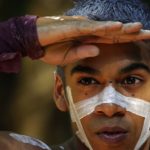A former psychologist and resident of Costa Rica looks back over ten years of legal and cultural progress for the lesbigay community in Costa Rica.
Also See:
Gay Costa Rica News & Reports 2008 to present
By Richard Stern
Reprinted from Gay and Lesbian Review
July-August 2001
Updated July 2007
Costa Rican lesbians and gay men have made significant gains in the last ten years. Although a gay traveller who was here in 1990 would hardly recognise gay life today, paradoxes still abound. Gay and lesbian life may now be legally protected and thriving, but the lives of lesbians and gay men remain divided between a supportive peer culture and a national culture which still condemns and vilifies them.
I’ve lived here for twelve years, and have witnessed first-hand many of the striking changes that have affected the gay community in this tiny Central American country. Costa Rica, which likes to call itself the Switzerland of Central America, is a mountainous country with a population of 3.5 million people, nestled between Panama on the South and Nicaragua on the North. San José, the country’s most populous city, sits at an altitude of 4,000 feet and has a perpetually spring-like climate.
Its extended metropolitan area is home to nearly two-thirds of the country’s population, including the majority of lesbians and gay men, who migrate to San José from the monotony and conservatism of rural areas. Costa Rica decriminalised homosexuality between consenting adults in the 1970s. Since then, a series of legal rulings, on a judicial as well as administrative level, have turned things around for lesbians and gay men.
Legal and Social Changes
Supreme Court judgements over the last six years have prohibited bar raids, supported the right of gay saunas to operate, and ensured that people living with AIDS get state-of-the-art medical treatment. But culture changes far more slowly than law, and the traditional Costa Rican Roman Catholic family is still grappling with the concept of a gay son or a lesbian daughter.
The "machista" culture makes the lives of many gay men and lesbians uncomfortable and difficult. Machismo dictates that women should be passive, domestic, and sexually accommodating, while men are expected to be dominant, aggressive, and heterosexual. An effeminate boy or masculine girl may be tormented unmercifully in high schools, and even by their own family members.
I worked as a psychologist in local Non-Governmental Organisations for five years, providing support to sexual minorities and people living with Aids. Many of the clients I treated had, at one point or another, been on the verge of suicide because of rejection at home or in school. One client, Mario, came to see to me after taking an overdose in 1996 that nearly killed him. At the age of 18, just after high school graduation and before he’s even had a homosexual experience, he decided that death was preferable to a life in which he could only envision scorn and rejection from his machista father and traditional Roman Catholic family.
Part of the therapy was allowing Mario to see alternatives which existed within Costa Rica’s emerging gay community, and now, four years later, he works in a travel agency, and shares a small apartment with his lover. His family has come to accept him as he is, but they still keep a certain distance from his personal life and his boyfriend.
Lawyer Marco Castillo has been involved in gay activism for more than 20 years. He notes that there is now "generally much greater tolerance and respect for gays and lesbians than there was 20 years ago. You can see this in the more balanced media coverage, as well as in the fact that politicians are now also talking openly about it. 25 years ago the only news coverage you would find was completely denigrating and sensationalistic."
In the last few years, presidential candidates Antonio De Santi and Miguel Corrales have both been interviewed by the gay press. Each indicated they uphold a position of tolerance and respect toward the gay community. Such interviews were unheard of ten years ago. We received another boost when a famous TV newsreader, Marcello Castro, came out in an interview with Dino Starcevic of Costa Rica1s gay newspaper Gayness. It had been an open secret for years that Castro was gay, but in the mid-1990s he had temporarily retired from television because of the stress of leading a double life. He returned two years ago to anchor the nation’s major TV evening news programme.
In coming out, Castro becomes one of very few Latin American celebrities to publicly announce their homosexuality. After a Supreme Court ruling in 1997, the Costa Rican National Health Care system is providing anti-retroviral medications to nearly 900 people with Aids, at a cost of about $7 million dollars. Of these, 600 are estimated to be gay and bisexual men. But, two years after it announced its intention to do so, the government has still to implement a publicity campaign focusing on HIV prevention.
Guillermo Murillo, who founded the Costa Rican Association of People Living with AIDS and was one of the signers of the Supreme Court appeal, recognises the ambivalent nature of Costa Rica’s handling of the AIDS epidemic. "We have the best medical attention for AIDS in all of Central America, and the mortality rate has dropped dramatically in the gay community," he says. "But historically the Catholic church has inhibited a frank discussion of sexuality in public high schools, and the government has no organised prevention strategy. In the area of prevention we are probably last in Central America."
Gay Scene Emerging
The gay scene in Costa Rica is also beginning to blossom. In San José, you can choose between any one of a dozen downtown bars and clubs, four saunas, an internet café, and more than a handful of gay friendly restaurants, hotels and other businesses. There’s a small gay area, just south of Central Park, that caters to local and foreign visitors alike. It’s host to four gay venues; the Avispa, Las Cucharrones, Cantabrico and Margot. A fifth, Moulin Rouge, turns gay as the evening wears on.
In the streets adjacent to these bars, meandering transvestite prostitutes are protected from police harassment by Court rulings— though not necessarily from muggers and occasional queerbashers. The neighbourhood, although dingy, is decidedly gay and relatively safe to walk around in the early hours of the evening. But anyone leaving the bars after midnight should catch a taxi back to the hotel.
The Avispa, one of Costa Rica’s oldest bars, celebrated its 21st anniversary in May. The lesbian owner, Ana Vega, has been a consistent supporter of activism ever since she opened the bar. On a Sunday afternoon the Avispa is packed with a young crowd taking advantage of that day’s free admission policy. Downstairs, hundreds of men and women dance on two smoke filled floors to the latest music imported from the USA. Upstairs, there’s a restaurant and several pool tables.
One of my favourite places, Cantabrico, is totally politically incorrect. The bar is owned by straight people who refuse to participate in Costa Rica’s emerging gay political scene. But for more than 15 years it has been home to a working class crowd of men and women who sit at its old wooden tables listening to romantic Latin ballads late into the night. My friend, the Argentine artist Victor Florida, once described Cantabrico as "charming "it’s a completely 1950s type of place. It should be preserved as an historic site."
More recently saunas have become the place to go. Sauna Paris, just two blocks west of the downtown Holiday Inn, has earned its reputation as a chic, US-style bath-house, promoting promiscuous, but safer, sex. Sauna Paris has also become part of the history of the struggle for gay rights in Costa Rica. Officials from the municipality of San José closed the sauna several times late in 1999, just after its inauguration, claiming that its presence was against Costa Rican standards of "proper behaviour and public morality."
But Sauna owner Sebastian Degand took his case to the Supreme Court and, on January 11th, 2000 the Court upheld Degand’s petition and ordered that Paris be reopened, pending a final ruling, arguing that "subjective criteria of morality and proper behaviour have no legal basis… and represent a violation of the fundamental rights granted by our Constitution." Degand hailed the ruling as an important victory for the gay community and expects to win the final ruling. (Unfortunately, Degand passed away in 2001)
Deja-Vu, which is located eight blocks south of Central Park, near an old, unused railroad station, in a worn out working class neighbourhood, has in recent years become the place to dress right and be seen (And you do have to dress right; several friends of mine showed up one night in plain white T-shirts and were denied admission). The dancefloor features elaborate strobe-lights and the midnight shows on Friday and Saturday nights are spectacular. The lines outside the bar on show nights are testimony to Deja-Vu1s popularity. Deja-Vu also took centre stage in one of the gay community’s most important legal battles.
On a busy Friday night in 1995 truckloads of police suddenly arrived at the bar, demanded identification from hundreds of guests, and arrested the bar’s owners on vague charges. But, together with local activists, the owners took the case to the Supreme Court, which declared the raid illegal and discriminatory. Since then, there have been no more bar raids in Costa Rica.
Activist and lawyer Marco Castillo thinks the Deja-Vu decision was a cornerstone of progress for Costa Rica’s gay/lesbian community. "Even in the 80s, raids on bars were common and people who were caught actually had their heads shaved by the police. But since the Deja-Vu decision, we have gained the right to feel secure in our centres of activity."
Almost all organised gay life in Costa Rica takes place in and around San José. However, the resort beach town of Quepos, near the spectacularly beautiful Manual Antonio National Park on Costa Rica’s Pacific coast, has become famous for its large expatriate gay community and is home to several gay friendly businesses. Quepos can boast at least three gay hotels, and an off-the-beaten track nudist beach. It’s also the home to several unfriendly fundamentalist priests and other eccentrics who have received much press coverage by denouncing the "homosexual menace" in Quepos.
But no amount of shouting in the streets has been able to dislodge Manual Antonio´s gay community. Most local residents seem to recognise that a substantial portion of tourist revenue comes from visiting gay men and lesbians, and there have been no new anti-gay activities there for more than two years. My Costa Rican friend Lorena lives with her husband and two children in Quepos. "Why should I care if there are gay people here?" she says. "They are good people."
From Gaymocracia: http://www.gaycostarica.com/
















